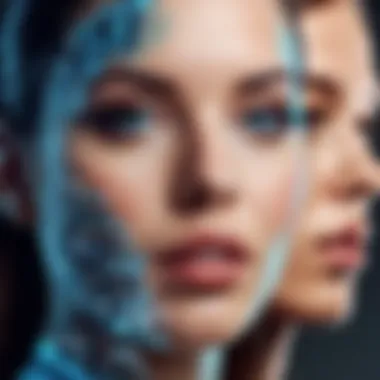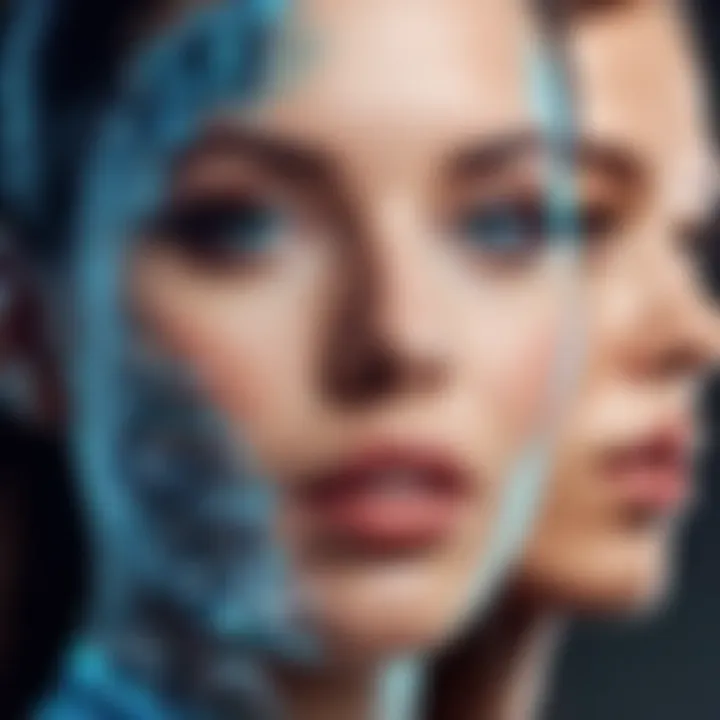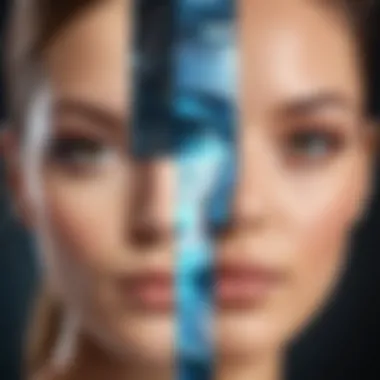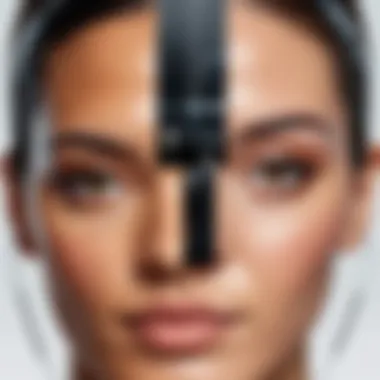Merging Faces with Music Videos: A New Era of Creativity


Intro
In the realm of digital creativity, the convergence of technology and artistic expression is constantly evolving. One of the most intriguing developments in recent years is the ability to integrate personal facial images into music videos. This technology provides users a chance to become part of their favorite songs, reshaping their interaction with music. The advancement not only alters user engagement but also challenges the conventional norms in the music industry.
Overview of the Technology
The technology underlying these applications combines face recognition algorithms with video editing tools. Users can upload their photos, which are then mapped onto avatars or performers in the music video. This process often leverages machine learning to ensure that facial expressions are accurately synchronized with the video’s movements.
- Key specifications: Users typically need a smartphone or a computer with a decent processor. Software applications may vary, but most require minimal installation, leveraging cloud computing to minimize local resource demand. The efficiency of facial mapping relies heavily on advanced algorithms that are capable of real-time processing.
- Unique selling points: These applications stand out for their user-friendly interfaces and extensive customization options. For instance, users can select different music genres, creating a personalized experience that enhances emotional connection to the content. Additionally, social media integration allows for easy sharing, broadening the appeal of these tools.
Design and Build Quality
Design plays a crucial role in the success of these applications. An intuitive layout makes it easy for users to navigate through options without steep learning curves. The aesthetic should appeal to a tech-savvy audience seeking a seamless creative process.
- Material used: Most applications run on existing platforms such as iOS or Android. As such, the design incorporates coding languages like Swift or Kotlin and utilizes modern frameworks like React Native for cross-platform compatibility.
- Ergonomics and usability: Good usability is marked by responsive controls and fast load times. The interface should allow for quick adjustments, enabling users to find the perfect fit for their images and chosen clips. Testing usability through beta versions affords developers valuable insights into user experience, further enhancing the applications.
"The blending of personal identity with media opens up opportunities for new forms of expression and engagement."
In summary, the technology for merging faces with music videos is not only about functionality but also about enhancing user experience. The implications of this technology echo throughout the music industry, shifting paradigms in content creation and audience involvement.
Prelims to Face Integration in Music Videos
The integration of faces into music videos is a transformative technology that has garnered significant attention in recent years. This innovation allows users to overlay their own facial images onto existing video content, creating a bridge between personal expression and artistic creativity. The implications of such a technique are vast, influencing both the creation of music videos and the ways audiences engage with them. Understanding the importance of this topic is crucial as it reveals the convergence of technology, art, and consumer behavior in the modern digital landscape.
From a technical perspective, these applications leverage advanced facial recognition and augmented reality to seamlessly blend faces with video. The benefits are noteworthy: they foster a participatory culture where fans can become part of the content they admire. This engagement can enhance fan loyalty and promote a sense of belonging within a community. However, there are also considerations around privacy and ethical use that must be addressed to protect users.
As we delve into the mechanics of face integration and its broader implications, it becomes clear that this topic is not merely about entertainment. It encompasses critical discussions about personal identity, digital rights, and the future of artistic expression in a technology-driven world.
Understanding the Concept
To grasp the significance of face integration in music videos, we must first understand the underlying concept. At its core, this technology hinges on the ability to recognize facial features and superimpose them onto existing visual media. Applications equipped with this feature utilize machine learning algorithms to identify and map facial geometries accurately. Users can then replace or overlay their own images on performers within a music video, creating a personalized viewing experience.
This process of merging faces can serve multiple purposes. For fans, it allows for greater involvement in music culture, transforming the act of watching a video into one of participation. For artists, it opens new avenues for creativity, allowing them to engage their audience in more interactive ways. The appeal lies in the blend of fantasy and reality; fans can imagine themselves alongside their favorite artists, experiencing music videos not just as spectators, but as active participants.
Historical Context
The historical context of face integration in music videos is essential to appreciate its evolution. Initially, music videos merely served as promotional tools for artists, with little interaction from viewers. As digital technology progressed, the types of content available expanded significantly. The introduction of social media platforms further amplified audience engagement, leading to a demand for more interactive content.
The rise of applications capable of merging faces with music videos can be traced back to advancements in facial recognition and augmented reality. Early attempts at face-swapping can be found in video games and social media filters, which gained popularity due to their novelty and fun. As technology matured, these capabilities transitioned into the realm of music, enabling fans to place their faces in videos of their favorite songs.
In summary, the integration of faces into music videos symbolizes a larger shift in media consumption. It reflects changing dynamics in the relationship between artists and fans, as technology continues to redefine the ways people connect through music.
Application Mechanics
Understanding the mechanics behind applications that merge faces with music videos is crucial. These applications not only enhance user interaction but also transform the creative landscape of digital media. In this section, we will explore three core elements: facial recognition technology, augmented reality elements, and video editing features. Each of these components plays a significant role in shaping the functionality and user experience of these innovative tools.
Facial Recognition Technology
Facial recognition technology serves as the foundation for merging facial images into music videos. It utilizes complex algorithms to analyze and identify facial features. This technology enables applications to detect a user's face in real time and accurately overlay it onto characters or scenery in a video, thereby creating an immersive experience.
The accuracy of facial recognition varies among different apps. Some applications employ advanced techniques such as deep learning to improve identification. Users often express appreciation for apps that deliver high precision and minimal lag, as it enhances the overall engagement. However, the effectiveness of this technology can be influenced by factors such as lighting conditions and camera quality.
Additionally, privacy concerns arise when personal data is used for recognition. Ensuring that the technology adheres to privacy regulations is essential for user trust. Users should be aware of how their data is collected and used in these applications.
Augmented Reality Elements
Augmented reality, or AR, is a key feature in applications that merge faces with music videos. AR allows users to interact with digital content in a real-world context by overlaying computer-generated images onto their view of the environment. This element contributes to a more engaging user experience, making the process fun and interactive.
The integration of AR in music videos is not merely about the digital insertion of faces; it also includes dynamic backgrounds, animated characters, and interactive effects. For instance, an app may allow users to sing along with animated avatars or manipulate their surroundings in real time. This level of interaction makes viewers feel more like participants rather than passive observers, which can greatly enhance the enjoyment of music videos.
"Augmented reality takes the user experience to another level, merging fun with creativity."


Despite these benefits, there are important considerations. Users may experience issues with AR if they lack the necessary hardware capabilities or if the app demands high-performance specifications. Additionally, the learning curve for some users can be steep, especially for those not familiar with technological interfaces.
Video Editing Features
Video editing features are essential for refining the final product when merging faces into music videos. These tools enable users to adjust various parameters such as timing, effects, and transitions, resulting in a polished output. Features like cropping, color correction, and adding filters can significantly enhance the visual appeal of the music videos.
Moreover, some applications provide templates and preset styles that streamline the editing process. This is particularly useful for users who may not have extensive editing skills. By offering a straightforward interface with drag-and-drop functionality, users can create professional-looking videos without the need for prior experience.
However, the depth of editing features may vary from one application to another. Some apps may offer advanced capabilities, catering to users looking for more intricate controls, while others focus on simplicity. The balance between user-friendly design and advanced functionalities is crucial for satisfying a diverse user base.
In summary, understanding the application mechanics is vital for appreciating the intricacies involved in merging faces with music videos. The interplay between facial recognition technology, augmented reality elements, and video editing features creates a rich tapestry of user experience, ultimately defining the success of these innovative applications.
User Experience
User experience plays a crucial role in the success and functionality of applications that merge faces with music videos. Such experiences need to be designed thoughtfully, as they influence user satisfaction and retention. In this context, assessing how users interact with these applications includes examining ease of use, customization options, and performance analysis. Focusing on these elements can enhance overall effectiveness and engagement.
Ease of Use
The ease of use of an application is a fundamental aspect that determines whether users will enjoy and continue using it. An intuitive interface allows users, regardless of their tech knowledge, to navigate seamlessly through features. This capability is especially important in music video applications where users may wish to quickly see results of their face integration.
Clear instructions and tutorials can facilitate a smoother onboarding process. Features that are straightforward and easily accessible contribute to an enjoyable experience. On the other hand, complex designs may create frustration, leading users to abandon the app altogether. Therefore, balancing innovative technology with user-friendly design is essential for ongoing user engagement.
Customization Options
Another significant factor in user experience is the availability of customization options. Users appreciate having the ability to personalize their content, tailoring music videos to their individual preferences. This can range from choosing different facial expressions, skin tones, or even backgrounds that reflect their unique style. Such features enhance creativity, allowing users to express themselves fully within the digital landscape.
Moreover, customizable filters and effects can also contribute to a richer interaction. By empowering users to adjust elements of their video, apps can deeply integrate personal flair into professional-looking outputs. This not only uplifts user satisfaction but increases sharing capabilities, turning personalized content into social currency.
Performance Analysis
Performance analysis is key for understanding how well an application works. Users want a smooth, quick experience since time efficiency is critical in the realm of entertainment. Delays in rendering or lagging effects can quickly detract from the enjoyment. Applications should thus implement robust backend technologies to handle processing efficiently.
Feedback mechanisms should also exist, allowing users to share their experiences. Such insights can guide developers in making necessary adjustments, leading to iterative improvements. Importantly, performance tracking can assist in optimizing user experience consistently, making sure the app remains competitive and capable of keeping up with user demands.
Effective user experience design directly correlates with user retention and satisfaction levels, making it essential for the success of face integration apps.
Major Applications in the Market
The intersection of facial integration technology and music videos has spurred a new wave of creative potential. Understanding major applications in the market is essential to grasping the influence these innovations have on both content creation and audience experiences. The applications not only enhance user engagement but also offer various creative tools that were previously unattainable in conventional video editing.
Overview of Leading Apps
Several applications exemplify the capabilities of merging faces with music videos. Notable among them are Zao, Reface, and FaceApp. Each of these platforms harnesses sophisticated algorithms to allow users to place their images seamlessly into existing music video frameworks.
Zao captured headlines for its almost instant face-swapping technology that delivers surprising results. Users simply upload their photos and can transform into popular music icons, leading to viral trends.
Reface takes it a step further, allowing users to create deepfake-style content easily. It is not just about fun; it empowers creators to produce unique remixes of existing music videos with a personal touch.
FaceApp has carved a niche by adding filters that go beyond conventional text and image overlays. It offers unique visual effects that can enhance the user’s appearance and set the desired mood in the videos they generate.
Comparison of Features
When comparing features among these major applications, certain functionalities stand out:
- Facial Realism:
Zao leads the way with highly realistic face swaps thanks to its advanced machine learning algorithms. Users can expect their faces to closely align with those of performers. - Ease of Use:
Reface provides an intuitive interface. Users can generate a video clip with a few clicks, which caters to both novice and expert users. - Creative Control:
FaceApp is recognized for offering extensive tools for photo editing prior to video integration, giving users a chance to customize their appearance even further.
Performance can also vary. While Zao runs smoothly in ideal network conditions, Reface may sometimes experience lag during peak usage hours. Nonetheless, all three applications distinguish themselves by creating engaging user experiences, allowing for the rapid production of personalized content.
User Recommendations
For tech-savvy individuals interested in merging faces with music videos, recommendations depend on what each user hopes to achieve:


- If seeking realism and high-quality alterations, Zao is the preferable choice.
- For individuals wanting quick edits and straightforward complexity, Reface is likely the best fit.
- Anyone looking to enhance their facial features before integrating them in videos could find FaceApp more suitable.
In sum, the application landscape for merging faces with music videos showcases a blend of entertainment and creativity, enabling users to participate in the culture of digital content creation. The insights from these applications highlight their role in shaping modern music video experiences and the additional creative avenues being explored by users today.
"As technology advances, the threshold of creativity continues to shift, presenting opportunities that redefine how we interact with music and video alike."
Staying informed about these major applications not only broadens our understanding of entertainment but also invites us to consider future developments to come.
Cultural Impact
The integration of faces in music videos represents a pivotal shift in the digital landscape, affecting both production practices and audience interaction. It is essential to understand the cultural impact of this phenomenon, as it shapes the way artists express themselves and how audiences process visual media. When users customize music videos with their own faces, they engage with the content on a deeper level, which results in a transformed relationship between the artist and the viewer.
Influence on Music Video Production
Modern music video production has evolved significantly with the rise of face integration apps. Artists no longer create videos with a one-size-fits-all approach. Instead, they consider how audiences might personalize their work. This change encourages a more interactive form of storytelling, where the viewer's identity becomes part of the narrative.
For instance, artists can now use engagement metrics to tailor their content, focusing on collaboration with fans rather than solely presenting their vision. This enhances the emotional connection that viewers feel towards the music.
Some notable points about this transformation include:
- Increased Engagement: The ability for fans to insert their faces into videos increases their emotional investment in the content.
- Collaborative Nature: Emerging technologies allow for more collaboration between artists and their audiences, making the process of creation more community-oriented.
- Diverse Representation: With various faces appearing in music videos, there is a wider range of representation, reflecting different cultures and identities.
Shifts in Audience Engagement
The introduction of face integration has led to significant shifts in how audiences engage with music videos. Traditional consumption is being replaced by active participation. Users express their identities through these apps, making them co-creators of content rather than mere spectators. This dynamic encourages a greater sense of belonging.
Some noteworthy shifts include:
- Personalization: Users create videos that reflect their individuality, leading to a more personalized experience.
- Community Building: Sharing custom videos fosters community interaction, allowing fans to connect with each other and with artists.
- Virality Potential: Customized content often goes viral due to its unique nature, which further promotes artist visibility and cultural relevance.
New Avenues for Artistic Expression
Face merging technology offers new avenues for artistic expression that challenge traditional norms in the music industry. Artists can explore various visual themes and styles with the knowledge that fans will interact with these concepts. This not only broadens creative possibilities but also pushes the envelope regarding how music videos are produced and perceived.
The important aspects of this influence include:
- Experimentation with Styles: Artists can experiment with different genres and visuals, knowing audiences can adapt these to fit their personal aesthetic.
- Interactivity as Art: The act of merging faces becomes an art form, emphasizing interactivity over passive consumption.
- Fusion of Culture and Technology: This technology combines artistic expression with technological innovation, resulting in a new genre of media that reflects current cultural trends.
Privacy and Ethical Considerations
As the blending of personal images with music videos becomes increasingly prevalent, the discourse surrounding privacy and ethical considerations gains momentum. It is vital to navigate these topics to ensure that the technology serves its users without infringing on their rights or compromising their data security. The intersection of face-merging applications with music videos presents unique challenges, necessitating a thorough understanding of these implications.
Data Privacy Concerns
Most apps require users to agree to various privacy policies, which most people rarely read. According to various studies, many apps store facial images and related data indefinitely. This raises alarming questions:
- How securely is this data stored?
- Who has access to it?
- Can it be shared with third parties?
Addressing these concerns is critical for developers to maintain trust with their user base. Enhanced transparency about data handling practices can help alleviate users' fears.
Issues of Consent
Informed consent is another area demanding careful consideration. Users must not only agree to share their photos but also understand how those images will be used. The potential for misuse can occur unintentionally, as users may lack awareness of the implications of their images being integrated into a public-facing product.
To mitigate this, applications should incorporate clearer consent mechanisms. For example, apps could prompt users to explicitly consent to specific uses of their images, ensuring they remain informed about the process. Furthermore:
- Clear opt-in and opt-out options should be visible.
- Regular reminders about consent usage can enhance user awareness.
Regulatory Implications
As these technologies evolve, so do the regulatory frameworks governing them. Different countries have varying regulations regarding data protection, requiring apps to navigate complex legal landscapes. Laws such as the General Data Protection Regulation in Europe impose strict rules on consent and data usage. Users have the right to know how their data is used and can even demand its deletion.


Compliance with such regulations is not merely a legal obligation but serves as a ethical standard. Thus, developers need to:
- Stay updated on local and international data protection laws.
- Implement robust compliance programs that educate users about their rights.
Technological Innovations
AI and Machine Learning Advances
Artificial Intelligence and machine learning are reshaping how facial integration occurs in music videos. These technologies enable apps to analyze and process facial features in a real-time environment. This means that the applications can recognize and adapt to a user’s facial expressions, mimicking subtleties as diverse as smiles or raised eyebrows.
The following points illustrate how AI and machine learning contribute to the development of these applications:
- Enhanced Accuracy: AI algorithms now can achieve high fidelity in facial recognition, which increases reliability.
- User Interaction: Machine learning can adapt to users' preferences over time, leading to a personalized experience.
- Creative Flexibility: The tools provide various styles and effects, allowing users to experiment creatively with their appearance in videos.
However, the integration of such technologies also raises several concerns. Questions surrounding data security and algorithmic bias must be addressed. Users should be informed about how their data is utilized and ensure their privacy is protected.
Emerging Trends in Face Swapping
The trend of face swapping in music videos has gained traction in recent years, primarily fueled by increasing accessibility to sophisticated software. This has allowed both amateurs and professionals to partake in content creation in unprecedented ways.
Several factors are driving the emergence of this trend:
- User-Friendly Interfaces: Many platforms now offer intuitive interfaces that lower the barriers for entry, enabling more users to create compelling content with ease.
- Social Media Integration: With platforms like Instagram and TikTok promoting user-generated content, the demand for face-swapping has skyrocketed.
- Real-Time Processing: Technologies that support real-time face integration foster a dynamic and engaging viewing experience, allowing instant creativity.
"As social media platforms evolve, the ability to merge identities will likely form new forms of artistic expression and engagement."
These trends indicate a cultural shift towards personalized content creation. As users continue to engage with these technologies, the applications are likely to evolve, catering to feedback and expanding creative horizons.
In summary, both AI advancements and face-swapping trends are pivotal to the current landscape of music videos. These innovations are fundamentally changing how users engage with and redefine their digital identities. The continuous development in these areas will likely present fresh opportunities, allowing for deeper interaction between creators and their audiences.
Future Directions
Predictions for App Evolution
As technology continues to advance, applications that integrate facial images with music videos are likely to see notable enhancements. Future app evolutions could include improved AI algorithms that refine facial recognition and match user expressions with the music's mood. Also, we can expect a strong focus on user experience, making apps more intuitive and accessible. Features such as full-body integration might emerge, allowing users to not just swap faces but also customize their overall look in various video contexts.
Moreover, the introduction of virtual reality capabilities could provide users with immersive experiences. Imagine providing an opportunity to be a part of your favorite artist’s music video in a 3D environment.
The following list sums up some potential future app developments:
- Enhanced facial recognition algorithms
- Integration with virtual reality technology
- More advanced customization features
- Collaborative features for users to create music videos together
- Expansion of cultural themes and genres in the videos
Potential Market Growth
The market for applications that blend faces with music videos is on the brink of significant growth. As more users embrace digital platforms for content creation, the demand for innovative, interactive tools will likely increase. Not only does this technology cater to users' needs for self-expression, but it also opens new avenues for content creators and advertisers. Companies may invest more resources in personalized marketing strategies to capture the attention of these tech-savvy individuals.
According to recent industry trends, the following factors could contribute to market expansion:
- Rising popularity of user-generated content
- Increasing accessibility to mobile technology
- Growth in social media consumption
- Expanding demographic interest in digital creativity
“The future of music video apps lies in harnessing technology that empowers individual users while enhancing their creative capabilities.”
Finale
The topic of face integration in music videos is not merely a passing trend but a significant evolution in how we engage with digital media. As we have explored throughout this article, the technology behind these applications offers far-reaching benefits and raises important considerations. One of the primary benefits is the heightened creativity it affords users. By merging personal identities with music videos, individuals can express themselves in ways previously unavailable. The unique combination of personal images with popular content results in a personalized viewing experience, making the music more relatable on an individual level.
Apart from creative expression, these applications contribute to user engagement metrics. The more involved a viewer feels, the more likely they are to share content, driving organic visibility for artists and looks enhancing consumer engagement. Additionally, the integration of faces into music videos serves as a novel marketing strategy, appealing to a tech-savvy audience and capturing the attention of early adopters. This level of interaction reshapes the landscape of music video production, making it an exciting prospect for stakeholders across the industry.
However, it’s essential to acknowledge the complex implications of these technologies. Privacy concerns remain a poignant issue, particularly regarding data management and user consent. As these applications collect user data to enable facial recognition and AR elements, transparent practices must be paramount. Regulatory implications must be navigated carefully to ensure user protections are in place, maintaining trust within the user base.
In summary, the integration of personal faces in music videos reflects broader cultural shifts, a blending of technology and art that is redefining the very concept of the music video itself. As we look forward, it will be vital to balance the technological advancements with ethical considerations. The long-term success of these applications depends not only on innovation but also on how well they safeguard user interests while enabling creative growth.
Summary of Key Points
- Creative Expression: Offers unique ways for users to personalize music videos with their faces.
- User Engagement: Increased interactivity leads to higher engagement and social sharing.
- Market Strategy: Serves as an effective marketing tool for artists targeting a tech-savvy audience.
- Privacy Concerns: Raises important discussions on data privacy, user consent, and regulatory needs.
- Cultural Impact: Reflects significant shifts in the music industry and digital content creation.
Final Thoughts
The future of face integration in music videos is promising. As technology continues to evolve, we can expect more sophisticated applications. They will likely enhance the user experience further and create more collaborative environments between creators and consumers. However, stakeholders must remain vigilant concerning ethical practices. This approach will not only ensure user trust but also sustain long-term growth in this rapidly evolving field. By placing importance on both creativity and responsibility, the industry can harness these innovations for significant cultural impact.







